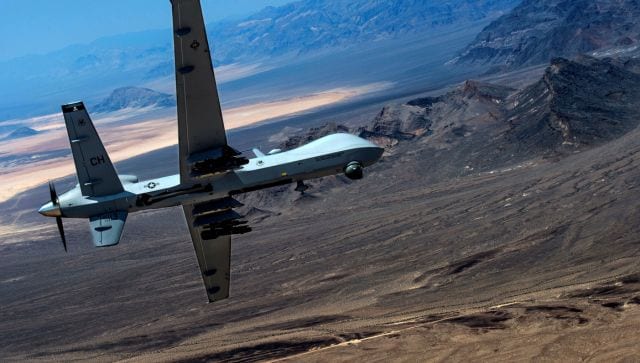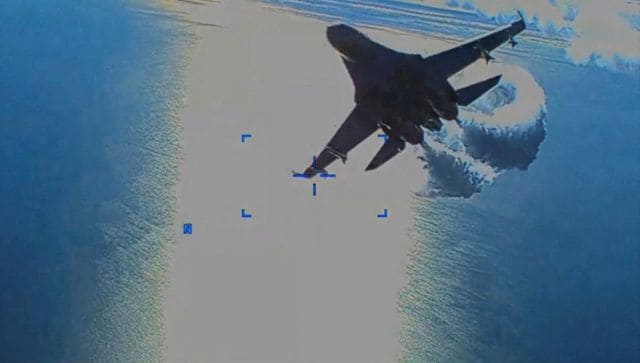India and the United States are expected to sign a $3 billion deal for MQ-9 Reaper or Predator B drones. This comes after Defence Acquisition Council (DAC), led by Defence Minister Rajnath Singh, on Thursday (15 June) reportedly gave a green light to procure armed Predator B Unmanned Aerial Vehicles (UAV). As per the news agency ANI, the procurement now needs to be cleared by the Cabinet Committee on Security. The deal will likely be announced during Prime Minister Narendra Modi’s state visit to the US next week. What is this MQ-9 UAV and how will it be beneficial for India? Let’s take a closer look. Features of Predator B drones According to ThePrint report, India will buy 30 MQ-9 Reaper drones from American manufacturing firm General Atomics Aeronautical Systems (GA-ASI). This will be a tri-service acquisition with Indian Navy getting a larger share than the Army and the Air Force, the report added. With an endurance of over 27 hours, MQ-9 Reaper can operate up to 50,000 feet, as per the GA-ASI.
The Reaper is 11 metres long and has a wingspan of over 22 metres.
It has a 240 Knots True Airspeed (KTAS) and a 1746 kilogram payload capacity, including 1361 kilograms of external stores. [caption id=“attachment_12751372” align=“alignnone” width=“640”] The Reaper has a two-member crew, comprising the pilot and sensor operator. Reuters File Photo[/caption] As per GA-ASI, the MQ-9 Reaper drone is equipped to carry multiple mission payloads to include “Electro-optical/Infrared (EO/IR), Lynx multi-mode Radar, multi-mode maritime surveillance radar, Electronic Support Measures (ESM), laser designators, and various weapons and payload packages”. The ‘M’ stands for multi-role, the ‘Q’ refers to a remotely piloted aircraft system and the ‘9’ means the ninth in the series of remotely piloted aircraft systems, noted the US Air Force (USAF). The UAV is remotely operated by a two-member crew, comprising the pilot and an aircrew member to operate the sensors and weapons. As per the US Air Force, the Reaper is capable of employing “eight laser-guided missiles, air-to-ground missile-114 Hellfire, which possess highly accurate, low-collateral damage, anti-armour and anti-personnel engagement capabilities.” The predecessor of Reaper, the Predator, came to be known for its use during the Iraq and Afghanistan wars, where it caused a high number of civilian casualties in “precision strikes”, noted The Guardian. The RQ-1/MQ-1Predator was retired by the USAF in 2017, with Reaper becoming the forces’ primary unmanned aircraft. The maritime variant of the MQ-9B drone is called SeaGuardian, while the other variant is known as SkyGuardian. The Indian Navy has been operating two unarmed SeaGuardian drones on lease since September 2020. These drones, which have an endurance of over 30 hours, have been deployed to keep an eye on Chinese military activities along the Line of Actual Control (LAC) following the 2020 Galwan Valley stand-off between the two countries, reported Times of India (TOI). In November 2022, General Atomics said these leased drones completed 10,000 flight hours during a two-year period since their first flight on 21 November 2020. “Our MQ-9As have helped the Indian Navy to cover over 14 million square miles of operating area,” Linden Blue, CEO of GA, had said. ALSO READ:
How India has one-upped China with its dual aircraft-carrier exercise
How will MQ-9 drones benefit India? With its long-endurance, persistent surveillance and strike capability, the MQ-9 Reapers can enhance the Intelligence-Surveillance-Reconnaissance (ISR) capabilities of India’s armed forces. According to the US Air Force, Reaper is primarily used as an “intelligence-collection asset and secondarily against dynamic execution targets”. “Given its significant loiter time, wide-range sensors, multi-mode communications suite, and precision weapons, it provides a unique capability to perform strike, coordination, and reconnaissance against high-value, fleeting, and time-sensitive targets,” the USAF said. As per TOI, these Predator B
drones
can help India in long-range surveillance and strike capabilities both in the Indian Ocean Region (IOR) and on the land borders. Citing Indian military planners, India Today said in a report in January this year that armed drones can help Indian forces to “launch remote-controlled operations and surgical strikes, such as on terrorist hideouts in Pakistan-occupied Kashmir, and engage targets on the Himalayan borders with China.” Which countries use it? The Reapers have been procured by the US Air Force, the US Department of Homeland Security, NASA, the United Kingdom’s Royal Air Force, the Italian Air Force, the French Air Force and the Spanish Air Force. Recently, Japan inducted the MQ-9B Sea Guardian drones. Between 2014 to 2018, the UK deployed Reaper drones in more than 2,400 missions in Iraq and Syria, striking 398 times, as per The Guardian. In March, a Russian Su-27 aircraft dumped fuel on the MQ-9 Reaper over the Black Sea. The Russian jet also hit the propeller of the drone, leading the remote drone operators to down the unmanned aerial vehicle in international waters. [caption id=“attachment_12751382” align=“alignnone” width=“640”]
The Reaper has a two-member crew, comprising the pilot and sensor operator. Reuters File Photo[/caption] As per GA-ASI, the MQ-9 Reaper drone is equipped to carry multiple mission payloads to include “Electro-optical/Infrared (EO/IR), Lynx multi-mode Radar, multi-mode maritime surveillance radar, Electronic Support Measures (ESM), laser designators, and various weapons and payload packages”. The ‘M’ stands for multi-role, the ‘Q’ refers to a remotely piloted aircraft system and the ‘9’ means the ninth in the series of remotely piloted aircraft systems, noted the US Air Force (USAF). The UAV is remotely operated by a two-member crew, comprising the pilot and an aircrew member to operate the sensors and weapons. As per the US Air Force, the Reaper is capable of employing “eight laser-guided missiles, air-to-ground missile-114 Hellfire, which possess highly accurate, low-collateral damage, anti-armour and anti-personnel engagement capabilities.” The predecessor of Reaper, the Predator, came to be known for its use during the Iraq and Afghanistan wars, where it caused a high number of civilian casualties in “precision strikes”, noted The Guardian. The RQ-1/MQ-1Predator was retired by the USAF in 2017, with Reaper becoming the forces’ primary unmanned aircraft. The maritime variant of the MQ-9B drone is called SeaGuardian, while the other variant is known as SkyGuardian. The Indian Navy has been operating two unarmed SeaGuardian drones on lease since September 2020. These drones, which have an endurance of over 30 hours, have been deployed to keep an eye on Chinese military activities along the Line of Actual Control (LAC) following the 2020 Galwan Valley stand-off between the two countries, reported Times of India (TOI). In November 2022, General Atomics said these leased drones completed 10,000 flight hours during a two-year period since their first flight on 21 November 2020. “Our MQ-9As have helped the Indian Navy to cover over 14 million square miles of operating area,” Linden Blue, CEO of GA, had said. ALSO READ:
How India has one-upped China with its dual aircraft-carrier exercise
How will MQ-9 drones benefit India? With its long-endurance, persistent surveillance and strike capability, the MQ-9 Reapers can enhance the Intelligence-Surveillance-Reconnaissance (ISR) capabilities of India’s armed forces. According to the US Air Force, Reaper is primarily used as an “intelligence-collection asset and secondarily against dynamic execution targets”. “Given its significant loiter time, wide-range sensors, multi-mode communications suite, and precision weapons, it provides a unique capability to perform strike, coordination, and reconnaissance against high-value, fleeting, and time-sensitive targets,” the USAF said. As per TOI, these Predator B
drones
can help India in long-range surveillance and strike capabilities both in the Indian Ocean Region (IOR) and on the land borders. Citing Indian military planners, India Today said in a report in January this year that armed drones can help Indian forces to “launch remote-controlled operations and surgical strikes, such as on terrorist hideouts in Pakistan-occupied Kashmir, and engage targets on the Himalayan borders with China.” Which countries use it? The Reapers have been procured by the US Air Force, the US Department of Homeland Security, NASA, the United Kingdom’s Royal Air Force, the Italian Air Force, the French Air Force and the Spanish Air Force. Recently, Japan inducted the MQ-9B Sea Guardian drones. Between 2014 to 2018, the UK deployed Reaper drones in more than 2,400 missions in Iraq and Syria, striking 398 times, as per The Guardian. In March, a Russian Su-27 aircraft dumped fuel on the MQ-9 Reaper over the Black Sea. The Russian jet also hit the propeller of the drone, leading the remote drone operators to down the unmanned aerial vehicle in international waters. [caption id=“attachment_12751382” align=“alignnone” width=“640”] A Russian Su-27 military aircraft dumped fuel on MQ-9 Reaper drone over the Black Sea in March. Reuters File Photo[/caption] Top Iranian general Qassem Soleimani was killed in a US drone strike in Iraq in January 2020, which was believed to have been conducted by an MQ-9 Reaper drone. With inputs from agencies Read all the
Latest News
,
Trending News
,
Cricket News
,
Bollywood News
,
India News
and
Entertainment News
here. Follow us on
Facebook
,
Twitter
and
Instagram
.
A Russian Su-27 military aircraft dumped fuel on MQ-9 Reaper drone over the Black Sea in March. Reuters File Photo[/caption] Top Iranian general Qassem Soleimani was killed in a US drone strike in Iraq in January 2020, which was believed to have been conducted by an MQ-9 Reaper drone. With inputs from agencies Read all the
Latest News
,
Trending News
,
Cricket News
,
Bollywood News
,
India News
and
Entertainment News
here. Follow us on
Facebook
,
Twitter
and
Instagram
.
)